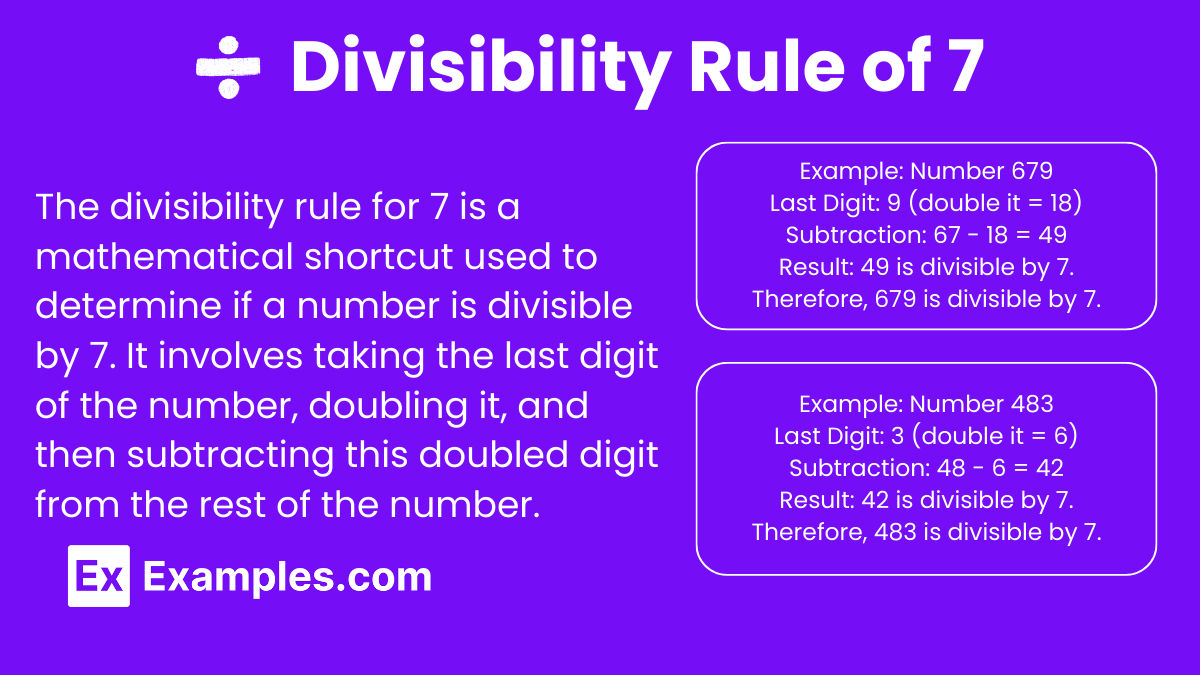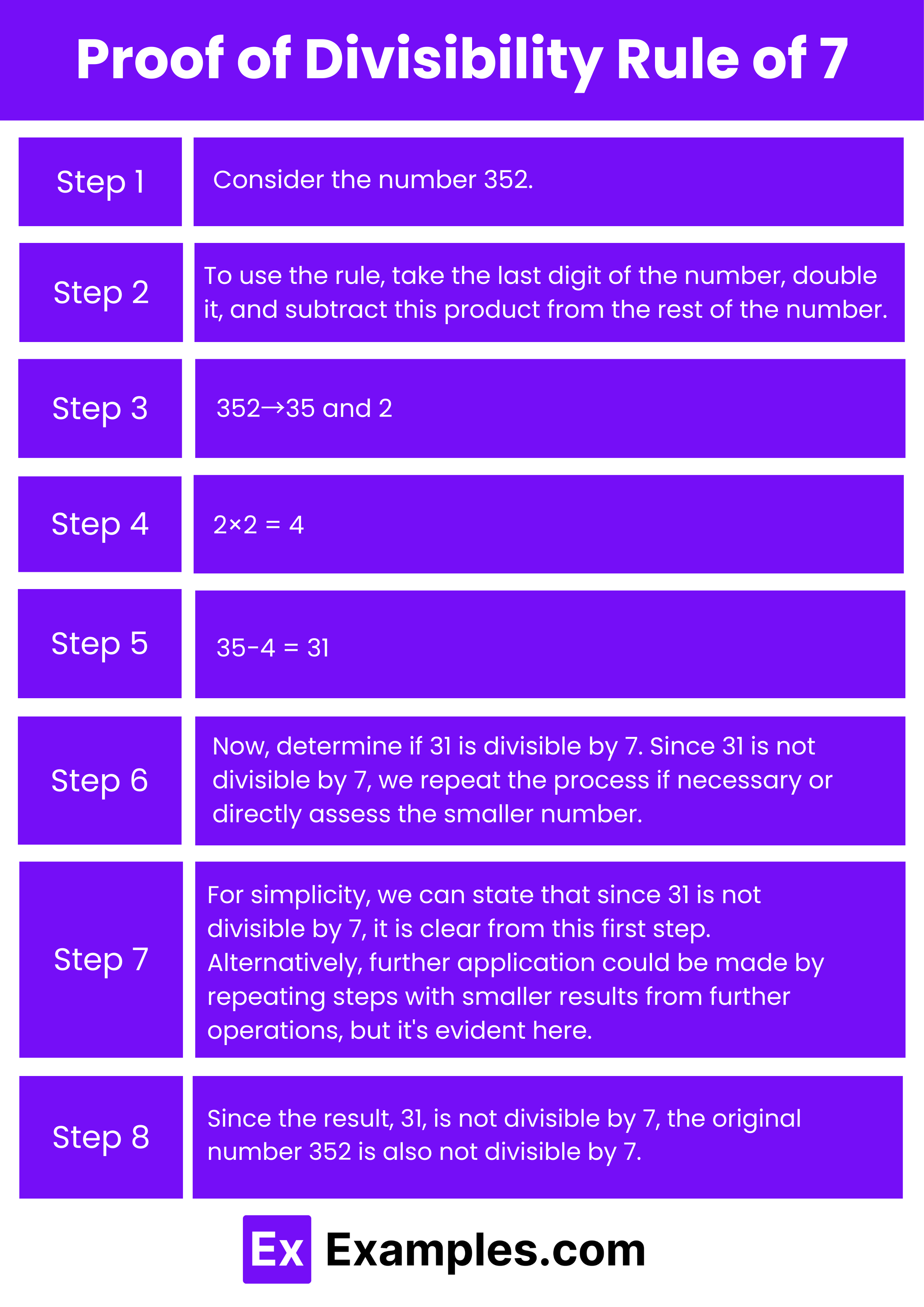Which of the following numbers is divisible by 7?
142
238
321
455


The divisibility rule for 7, while less straightforward than rules for smaller numbers, is a useful mathematical tool for identifying divisibility within the integer subset of rational number. This rule involves taking the last digit of the number, doubling it, and then subtracting this product from the remaining leading truncated number. Repeating this process as needed can indicate divisibility by 7 when the resulting smaller number is known to be divisible by 7. In algebra and arithmetic, mastering this rule enhances one’s ability to simplify and factorize expressions and solve equations efficiently. The rule applies specifically to integers, aiding significantly in tasks involving addition, subtraction, multiplication, and division.
Download Proof of Divisibility Rule of 7 in PDF

Download Proof of Divisibility Rule of 7 in PDF
To prove the divisibility rule for 7 using a specific number, let’s use the number 352. Here’s the step-by-step explanation of how the rule applies to this number:
To use the rule, take the last digit of the number, double it, and subtract this product from the rest of the number.
352→35 and 2
2×2 = 4
35−4 = 31
Now, determine if 31 is divisible by 7. Since 31 is not divisible by 7, we repeat the process if necessary or directly assess the smaller number.
For simplicity, we can state that since 31 is not divisible by 7, it is clear from this first step. Alternatively, further application could be made by repeating steps with smaller results from further operations, but it’s evident here.
Since the result, 31, is not divisible by 7, the original number 352 is also not divisible by 7.
For the number 203:
For the number 2728:
Consider the number 161:
Consider the number 455:
Yes, the rule applies to any integer, whether positive or negative. It helps in quickly determining if the number is divisible by 7 without performing complete division.
Yes, if the result of the initial application is still too large to assess easily, you can repeatedly apply the rule to the new result until a clear determination can be made.
Doubling the last digit and subtracting it from the rest of the number simplifies the number to a smaller one that can more easily be checked for divisibility by 7. This particular operation alters the number in a way that maintains its divisibility characteristics regarding 7.
If you get a negative result, you can continue applying the rule or check if the absolute value of the result is divisible by 7. The sign does not affect divisibility by 7.
Absolutely, knowing whether the numerator or denominator is divisible by 7 can help in reducing fractions to their simplest form.
The rule for 7 involves more steps and requires subtractive manipulation, unlike simpler rules for 3 or 5, which are based on the sum or the last digit of the number, respectively.
For a large number like 1729, you would take 9 (double it to 18), subtract from 172 to get 154. Since 154 is clearly divisible by 7 (154 ÷ 7 = 22), 1729 is also divisible by 7.
Introduce the rule step-by-step with examples and encourage practice with both small and large numbers. Visual aids or manipulatives can help demonstrate the subtractive process clearly.
The main limitation is that it might require multiple iterations to reach a manageable number, especially if the initial number is very large, making it potentially time-consuming compared to divisibility checks for smaller numbers like 2 or 5.
Text prompt
Add Tone
10 Examples of Public speaking
20 Examples of Gas lighting
Which of the following numbers is divisible by 7?
142
238
321
455
If a number is divisible by 7, which of the following must also be divisible by 7?
The number itself
Half of the number
The number plus 7
The number minus 1
What is the remainder when 123456 is divided by 7?
1
2
3
4
Which of the following numbers is NOT divisible by 7?
49
84
121
161
If 7 divides a number with a remainder of 5, what is the smallest possible number?
12
25
35
45
Which number from the list below is divisible by 7?
108
154
198
221
What is the result of subtracting 7 from a number divisible by 7?
The result will always be divisible by 7
The result will not be divisible by 7
The result will always be 7
The result will always be an odd number
Which number is the closest to 100 and divisible by 7?
98
105
112
119
If a number is divisible by 7, what is true about the sum of its digits?
The sum is always divisible by 7
The sum may or may not be divisible by 7
The sum is never divisible by 7
The sum is always an even number
What is the result of dividing 987 by 7?
140
141
142
143
Before you leave, take our quick quiz to enhance your learning!

